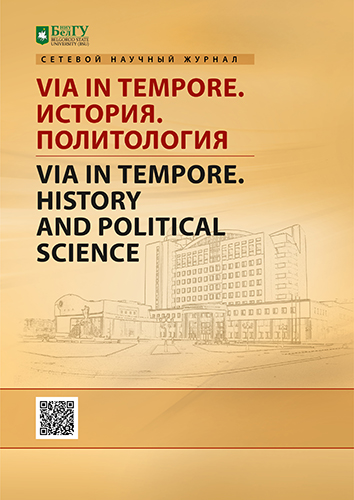CONSTRUCTIVIST MEDICAL COMPLEXES OF URALS IN THE ERA OF 1920es AND 1930es: ARCHITECTURE AND EXPOSITION
DOI:
https://doi.org/10.18413/2687-0967-2020-47-1-151-159Keywords:
hospital, constructivism, healthcare, industrialization, Urals, USSRAbstract
The paper deals with the analysis of geographical localization and architectural exterior of the large medical structures and complexes erected in Ural region during the period of forced industrialization in 1920es – 1930es. The total number of constructivist medical complexes is roughly 25 units in 12 cities of Urals, and they share the key stylistic features both in appearance and in exposition. The most prominent complexes are located in Sverdlovsk and Chelyabinsk, which, being the regional administrative centers, account for almost one-fifth of them. Most of the medical buildings, however, were erected in smaller industrial centers – Nadezhdinsk (Serov), Solikamsk, Berezniki, Lysva, Niznhy Tagil, Kamensk-Uralskii, Troitsk, Verkhnii Ufalei, Zlatoust, and Satka. In roughly a dozen years, the overall number of large medical complexes constructed in cities of Urals reached or even exceeded the overall number of medical complexes constructed during the previous hundred of years, and thus the intensity of construction in the field of healthcare increased greatly in the time of industrialization. Thus, the constructivist buildings which we describe, are representing coherent and important part of the national heritage both in terms of cultural legacy of Soviet avantgarde and in terms of the history of key moment in the development of Russian healthcare system which, since that moment, became massively spread. However, the allocation of the newly erected structures was rather lopsided, since the deployment of medical infrastructure depended not only upon the priorities of industrialization but also upon the base that already existed and upon the deficit of resources, which was especially bad in the new construction sites.
Downloads
References
Белостоцкий И.С. 1928. Больничное строительство в Свердловской области. Ураль-ский медицинский журнал, 1: 19–28.
Бугров К.Д. 2018. Соцгорода Большого Урала. Екатеринбург, Издательство Уральско-го университета, 472.
Букин В.П., Пискунов В.А. 1982. Свердловск. Перспективы развития до 2000 года. Свердловск, Средне-Уральское книжное издательство, 256.
Гаврилова С.И. 2011. Комплексная застройка Каменска-Уральского 1930-х годов: реа-лизованные и нереализованные проекты. Архитектон: известия вузов, 4: 85–98.
Дедов А. 2004. Здравоохранение (после 1917 г.) Златоустовская энциклопедия. URL: http://www.zlatoust.ru/a/ze/ze.html?946,947 (дата обращения: 29.07.2019).
Звагельская В.Е. 2014. Типологические и композиционно-стилистические особенности общественных зданий в архитектуре Урала (середина XIX – начало XX вв.). Академический вест-ник Уралниипроект РАСН, 3: 51–55.
Клементьева Н.В. 2013. Здравоохранение Южного Урала (1917–1936 гг.) Автореф. дис. … канд. ист. наук. Оренбург, 26.
Материалы к отчету о работе Молотовского городского совета РК и КД за время с 1 октября 1933 года по 1 октября 1934 года. Молотово: Тип. МЗ им. Молотова, 1934.
Машевич Е.А. Об организации единого диспансера ЧТЗ в г. Челябинске. Вестник Со-вета молодых учѐных и специалистов Челябинской области. 2016. 4: 131–134.
О больнице. Официальный сайт ГБУЗ «Районная больница г. Сатка». URL: http://medsatka74.ru/about/index.php (дата обращения: 30.07.2019).
Островкин Д.Л. 2016. Кадровое обеспечение здравоохранения на Урале в 1918–1941 гг. Историческая и социально-образовательная мысль. 4/2: 44–49.
Островкин Д.Л. 2019. Развитие сети инфраструктурных учреждений сферы здраво-охранения на Урале в 1920-х гг. Историко-педагогические чтения, 23: 96–100.
Отчет Челябинского совета РК и КД перед избирателями. Челябинск, 1938.
Пермь. Пермь: Кн. изд-во, 1957.
Семякин Г.В. Историко-культурные и типологические особенности лечебных зданий и комплексов архитектуры конструктивизма 1920 – 1930-х годов на примере городов северо-восточного региона Украины. Сучаснi проблеми архiтектури та мiстобудування. 2014. Випуск 37: 67–79.
Смирнов Л.Н. 2015. Петербургский след в архитектуре Екатеринбурга. Екатеринбург, Архитектон, 148.
Токменинова Л.И. 2012. Институты физиотерапии и профзаболеваний. Медгородок. Георгий Голубев. Екатеринбург, Tatlin, 48.
Фомичев И.А. 2013. Город Надеждинск. 1893–1940 гг. Екатеринбург, [б/и], 572.
Хан-Магомедов С.О. 2001. Архитектура советского авангарда. Т. 2. Социальные про-блемы. М., Стройиздат, 712.
Черноухов Э.А. 2016. Социальная инфраструктура горнозаводских округов Урала в XIX в.: казенный и частный типы. Дис. … доктора ист. наук. Екатеринбург, 535.
Штин О.В., Дектерев С.А. 2012. Конструктивизм в архитектуре общественных зданий Нижнего Тагила. Академический вестник УралНИИпроект РААСН, 2: 61–65.
Kotkin S. 1996. The Search for the Socialist City. Russian History, 1/4 (23): 231–261.
Deschepper J. 2017. Mémoires plurielles et patrimoines dissonants: l‘héritage architectural soviétique dans la Russie poutinienne. Le Mouvement Social, 260: 35–52.
Abstract views: 868
Share
Published
How to Cite
Issue
Section
Copyright (c) 2020 Via in tempore. History and political science

This work is licensed under a Creative Commons Attribution 4.0 International License.


